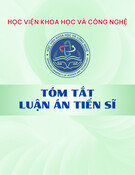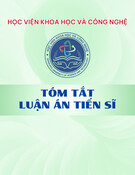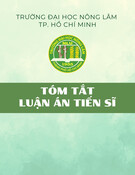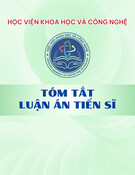MINISTRY OF EDUCATION AND TRAINING - -
HOANG THI LE THUONG
STUDY ON SCREENING YEAST STRANS FOR APPLICATION TO BRANDY PRODUCTION FROM PINEAPPLE QUEEN
SUMMARY OF PhD THESIS IN BIOLOGY
Hanoi - 2020
The thesis was completed at Hanoi National University of Education
Supervisors: Nguyen Quang Hao, PhD.
Tran Thi Thuy, PhD.
Reviewer 1:...............................................
Reviewer 2:...............................................
Reviewer 3:...............................................
The thesis is defended at the doctoral thesis evaluation committee at
At ... :00 on ...., 2020
This PhD thesis can be found at:
Library of Hanoi National University of Education
1
INTRODUCTION Brandy is a very popular alcoholic beverage which is distilled from high quality
wine. Brandy has a stimulating effect on nerves, heart and digestive, so it should be used
in small amounts every day for good health. It suits the needs of many people especially
young people; therefore brandy consumption is increasing. However, most of the brandy used domestically now are imported: Imported volume of brandy is the 3rd ranking among spirits imported into Vietnam. The average annual growth of brandy market is
18.8% but the price is still high; so brandy has not yet been widely used in Vietnam.
Finding domestic sources of raw materials and appropriate technologies to produce
brandy proactively in Vietnam to meet consumer needs is necessary.
Pineapple is a popular fruit tree in Vietnam, it is distributed from the North to the
South. Total pineapple output is always ranked first in the fruit trees reaching 529,100
tons in 2007; 532,700 tons in 2011 and 579,982.3 tons in 2016. Pineapple fruit is rich in
nutritional composition. The acidity and high content of water, sugar, protein, vitamins
and minerals in the juice makes it suitable for production of quality wine to distill into
brandy with a specific flavor. So far, according to our documentation, researches on
pineapple in Vietnam are mainly on the process of preserving fresh fruits, drying, making
syrup and fermenting wine. Many companies, businesses and food research agencies have
conducted their researches and businesses to the process of producing brandy from lychee,
apple, plum, cashew fruit, etc... but there was only one project on pineapple brandy named
“Technology completing of producing fruit brandy (litchi, pineapple) on an industrial
scale" done by Eresson Beer Single Member Limited Company. In this project, yeasts
were collected from many domestic and foreign sources, and distillation process was done
in high-tech tower. Pineapple brandy produced from this project is on market exploration
in small quantities with high prices and has not yet popular. Therefore, researches in
processing pineapple traditionally into brandy shall provide scientific platform to organize
the production of brandy from pineapple in Vietnam; creates more opportunities to the
consumption of pineapple products; creates more jobs to farmers; contributes to economic
development of many pineapple planting localities.
Base on the requirements of production practices, in order to help farmers solving
pineapple consumption by processing methods, we conducted the project titled "Study on
screening yeast strains for application to brandy production from pineapple Queen”.
2
Target
Selecting a yeast strain having high activity of ethanol fermentation producing a
specific aroma of fermented pineapple Queen juice, suitable for the production of
comprehensive quality brandy from pineapple.
Objectives, scopes and delimitations
Objectives: Yeast strains isolated from the juice of pineapple Queen grown at Dong
Giao Farm - Tam Diep - Ninh Binh provice.
Research scopes and delimitations
- Microorganisms: Yeast trains for alcoholic fermentation were isolated from
pineapple juice.
- Source of pineapple: Dong Giao Farm - Tam Diep - Ninh Binh provice.
Research contents
(1) Screening a yeast strain having high capacity of ethanol fermentation and
producing specific aroma of fermented pineapple Queen juice in fermentation process
(2) Study on the biological characteristics of selected a yeast strain: Colony
morphology, cell morphology, ability to ferment sugars and utilize nitrate; identify the
taxonomy of the selected yeast strain; characterize the influence of different factors (such as
sugar content, nitrate, pH, and nitrogen source) on the growth and development of selected
yeast strain.
(3) Study on various factors affecting the ethanol fermentation of selected yeast strain
in pineapple juice: initial pH, temperature, content of organic acid and sugar, level of
dissolved oxygen, level of yeast inoculum; time course of wine fermentation in the juice of
pineapple Queen.
(4) Modify the yeast strain D8 by a random mutation technique.
(5) Study on the techniques of distillation, cleaning and aging pineapple brandy
New contributions
- This thesis contributes a systematic study on pineapple brandy production from
isolation and screening yeast strains, characterization of selected yeast strain, suitable
condition for seed cultivation and fermentation, suitable condition for distillation and
removal of impurities; suitable condition for brandy aging to some analysis of aroma
composition of pineapple brandy.
3
- Mutating selected yeast strain to produce high alcohol content of 15.1% (v / v) by
random mutation.
- Proposing the use of green bean sprouts extract instead of peptone in cultivation of
selected yeast strain for seed culture of pineapple wine before distillation to pineapple
brandy.
- Proposing a process to remove impurities in alkaline or acidic conditions and
combining chemical and physical methods.
Structure of the thesis
The thesis consists of 136 pages, including the following sections:
Introduction: 4 pages
Chapter 1. Overviews of research issues: 44 pages
Chapter 2. Materials and research methods: 23 pages
Chapter 3. Results and discussion: 63 pages
Conclusions and Recommendations: 2 pages
References: The thesis cited 45 Vietnamese references, 135 foreign language
references and 02 web pages.
CHAPTER 1: OVERVIEWS OF RESEARCH ISSUES
In this chapter, 03 issues related to the studies of this thesis were overviewed. These
are: (1.1) YEAST; (1.2) PINEAPPLE - RAW MATERIAL FOR BRANDY
PRODUCTION and (1.3) BRANDY PRODUCTION TECHNOLOGY.
In section “1.1. YEAST”, the history of research and use of yeast in the
production of alcohol (Section 1.1.1) around the world and in Vietnam were presented in
detail. Criteria of classification and selection of yeast strains (Section 1.1.3) were also
overviewed. Yeast species used in wine production belong to Saccharomyces genus
(including 286 species belonging to 17 genera). Biological characteristics of yeast
(Morphological and physiological characteristics: Section 1.1.2) and Effect of some
factors on the growth, development and fermentation of yeasts (temperature, pH,
dissolved oxygen concentration, sugar content, alcohol content, disinfectants, etc: Section
1.1.4) were presented in detail on page 15 to 20.
In section “1.2. PINEAPPLE - RAW MATERIAL FOR BRANDY
PRODUCTION”, the overview of (1.2.1) The origin of pineapple plants; (1.2.2) Overview
4
of pineapple cultivation and processing in Vietnam; and (1.2.3) The biological
characteristics and nutritional composition of pineapples were presented on pages 21 to
26.
Section “1.3. BRANDY PRODUCTION TECHNOLOGY” presented (1.3.1)
History of researches and production of brandy around in the world and in Vietnam,
from page 27 to page 33; (1.3.2) Wine fermentation for distillation of brandy on pages
34 to 38; (1.3.3) Distilled wine for brandy; (1.3.4.) Aging brandy on page 38 to 44; and
(1.3.5) Criteria for evaluating brandy in Vietnam from pages 45 to 48.
In section 1.3.1 (History of researches and production of brandy around the world
and in Vietnam, some brandies from different countries (France, Spain, Italy, Germany,
USA and Latin America ...) together with their technological processes of brandy
production such as the process of producing Cognac were oveviewed. The present situation
of wine fermentation and brandy production in Vietnam was also mentioned in detail.
In section 1.3.2. (Wine fermentation for distillation of brandy), we overviewed: (1)
Mechanism of wine fermentation; (2) Process of wine fermentation from the preparation of
raw materials, preparation of fermentation medium and yeast inoculum; main and extra
stages of fermentation were well described.
In section 1.3.3. (Distilling wine for brandy) and section 1.3.4. (Aging brandy), we
described different techniques of distilleries (discontinuous distillation, refinement and
continuous distillation). Alcoholic purification and aging brandy were also mentioned in
detail.
In section 1.3.5. (Criteria for evaluating brandy in Vietnam), we overviewed
the standards for raw material, organoleptic, chemical composition; limits on heavy
metal components, food additives and specifications for packaging, labeling,
preservation and transportation of brandy were presented in detail.
CHAPTER II: MATERIALS AND METHODS
Materials, chemicals and equipments were presented in “section 2.1” included:
2.1.1. Raw materials, 2.1.2. Chemicals and media 2.1.3. Strains of microorganisms and
2.1.4 Research equipment.
Research Methods (2.2) was divided into 04 main following groups:
5
2.2.1. Microbiological methods include: Sample dilution for yeast isolating; Isolation of yeast on Hansen agar plates; Preparing slide of single staining from live specimen and
fixed yeast cells; Preservation of yeast strains; Activating yeast cells; Method of counting
yeast cells; Morphology study of yeast colonies and cells; Determination of alcoholic
fermentation activity; Screening and selection of mutant yeast producing high content of
ethanol; Yeast identification and classification.
2.2.2. Chemical physical methods include: Determination of the pH value; Determination of the dissolved oxygen content; Determination of the total sugar content,
Determination of vitamin C and total acid content; Determination of ethyl alcoholic
content; Distillation and purification of alcohol; Determination of furfural content (mg/l);
Determination of fermentation efficiency.
2.2.3. Sensory analysis of brandy
2.2.4. Methods of data analysis and processing
CHAPTER III: RESULTS AND DISCUSSION
3.1. Isolation and screening of yeast strains from fermented juice extract of
pineapple Queen
3.1.1. Isolation of yeast from fermented juice extract of pineapple Queen
From natural fermented juice of pineapple Queen, we isolated 8 strains of yeast,
denoted as D1, D2, D3, D4, D5, D6, D7 and D8, capable of growing and fermenting ethanol
in the medium of high content of sugar and acid. Such isolation orientation created
favorable conditions for the selection of yeast strains with strong growth and good ethanol
fermentation under conditions of natural fermentation of Queen Pineapple juice and also
limited the contamination of other microorganisms.
3.1.2. Selection of yeast strains
a) Evaluation of the growth of 8 yeast strains isolated showed that the strains D1, D4 and D5 were able to grow well in the Hansen medium, the cell density reached over 130 × 106 cells/ml. The strains D2, D3 and D8 grew worse, reaching 121 - 128 × 106 cells/ml. The growth ability of D6 and D7 strains were the lowest (reaching less than 120 × 106 cells/ml).
b) Determination of capability of alcoholic fermentation of 8 isolated yeast strains
Main criteria used to select yeast strains in this study were: strong ability of alcoholic
fermentation; tolerance to high sugar concentration and low pH; producing typical aroma. The
6
ability alcoholic fermentation of 8 yeast strains D1 - D8 were assessed through the amount of
CO2 emitted after 120 hours of fermentation at 28 °C (Table 3.1). In addition, we also compared
the ability to produce typical aroma among 04 selected having high capability of ethanol
fermentation (D3, D4, D5 and D8).
7
Fermentation capacity was calculated by the amount of CO 2 generated (g/100ml)
D1
D2
D3
D4
D5
D6
D7
D8
Fermentation Time (h)
4.44 ±
5.06 ±
4.88 ±
5.38 ±
5.79 ±
5.02 ±
4.63 ±
5.10 ±
24
0.02
0.02
0.02
0.02
0.03
0.02
0.02
0.02
5.08 ±
6.25 ±
6.02 ±
7.0 2 ±
8.70 ±
6.84 ±
5.55 ±
6.48 ±
72
0.02
0.03
0.01
0.02
0.03
0.02
0.01
0.01
7.32 ±
7.63 ±
7.96 ±
7.82 ±
Table 3.1. Ethanol fermentation and flavoring capacity of 8 isolated yeast strains
8.13 ±
8.29 ±
9.67 ±
9.85 ±
96
0.02
0.03
0.02
0.01
0.01
0.02
0.03
0.01
7.35 ±
7.70 ±
8.24 ±
8.32 ±
9.73 ±
7.85 ±
7.98 ±
9.89 ±
120
0.02
0.01
0.03
0.02
0.02
0.03
0.02
0.03
++
++
+++
+++
+++
++
+++
+++
Scent
Note: Ability to create fragrance: +++: Very fragrant; ++: Medium fragrant; +: slightly fragrant
The ability of alcoholic fermentation of 4 selected yeasts strains D3, D4, D5, D8 at low
pH was show in Table 3.2. D8 strain was the strongest fermentation capacity, yielding from
9.65 to 9.88 g of CO2/100 ml of fermentation borth at pH 3.5 - 4.5. Moreover, at pH 3, while
other strains D3, D4 and D5 showed weak capacity of alcoholic fermentation; D8 strain did
ferment quite well, producing 9.10 g of CO2 per 100 ml of fermentation broth. Differences in
ethanol fermentability of selected yeast strains at 4.0 and 4.5 were not much (P <0.5). Thus, the
D8 strain which not only showed high fermentation capacity at low pH but also had high
fermentation capacity in wide range of pH, capable of producing typical fragrance was selected
for further study on pineapple wine fermentation and brandy production.
Table 3.2. The fermentation ability of 4 types selected yeast strains D3, D4, D5, D8 at low
Fermentation capacity was calculated by the amount of CO 2 emitted (g/100ml)
pH of the environment
D3
D4
D5
D8
2.5
2.79 ± 0.03
3.32 ± 0.02
3.07 ± 0.01
2.49 ± 0.2
3.0
8.88 ± 0.02
8.79 ± 0.03
6.92 ± 0.02
pH environments
9.10 ± 0.02
3.5
9.41 ± 0.01
9.44 ± 0.02
8.01 ± 0.02
9.65 ± 0.02
4.0
9.52 ± 0.01
9.62 ± 0.02
8.93 ± 0.02
9.88 ± 0.02
4.5
9.53 ± 0.02
9.63 ± 0.01
8.96 ± 0.03
9.97 ± 0.03
8
3.2. Biological characteristics of the selected yeast strain D8
3.2.1. Colony and cell morphology of yeast strain D8
Strain D8 was cultured on Hansen agar medium at 28 °C for 96 h, the colonies appeared to
be round, white, smooth border and the diameter of colonies was 0.43 - 0.66 cm (Figure 3.1).
Figure 3.1. Colony of D8 strain on Hansen agar medium at 28 °C after 96 h of cultivation
Cells of strain D8 are oval or ovoid in shape, about (3,2 - 4,2) × (4,5 - 5,4) μm in diameter,
budding unevenly at both poles and around mother cells, buds are about (2.5 - 3.0) × (4.3 - 5.3)
μm in diameter. The surface of many cells have budding scar; some cells have large and deep
concave scar up to about 1000 nm in diameter.
Figure 3.2. Cell of D8 strain under S4800-NHE electron microscope A - Mother cell, B - Bud, C – Deep concave scar on cell surface, D - Scar (splitting location of buds)
9
3.2.2. Biochemical - physiological characteristics of yeast strains D8
The physiological - biochemical characteristics and sugar metabolism of yeast strains
D8 were compared to the control yeast strains S. cerevisiae TCCY using API C 20 AUX kit
were shown in Table 3.3 and by using API ID32 C kit were shown in table 3.4.
Yeast strains
Triplet
Type of
Strains D8
Strains S. cerevisiae TCCY
Negative control
number
sugar
Result
Total
API
Result
Total
API
Result
Total
API
Point
Point
Point
reaction
point
identifier
reaction
point
identifier
reaction
point
identifier
I
O
3
3041130
7
7040130
0
0000000
+
1
-
0
+
1
+
2
-
0
GLU
+
2
+
4
-
0
GLY
-
0
-
0
0
-
0
0
II
2KG
-
0
0
-
0
-
0
ARA
-
0
-
0
-
0
XYL
-
0
-
0
4
-
0
0
III
ADO
-
0
4
-
0
-
0
XLT
-
0
+
4
-
0
GAL
+
4
-
0
0
-
0
0
IV
INO
+
1
1
-
0
-
0
SOR
-
0
-
0
-
0
MDG
-
0
+
1
1
-
0
0
V
NAG
+
1
1
-
0
-
0
CEL
-
0
-
0
-
0
LAC
-
0
+
1
3
-
0
0
VI
MAC
+
1
3
+
2
-
0
SAC
+
2
-
0
-
0
TRE
-
0
-
0
0
-
0
0
VII
MLZ
-
0
0
-
0
-
0
RAF
-
0
-
0
-
0
H / pH +
-
0
Note: +/-: Positive / Negative reaction; O: no sugar; GLU: D-glucose; GLY: glycerol; 2KG: calcium-2; keto-
gluconate; ARA: L-arabinose; XYL: D-xylose; ADO: adonitol (ribitol); XLT: xylitol; GAL: D-galactose; INO:
inositol; SOR: D-sorbitol; MDG: Methyl-αD-glucopyranoside; NAG: N-acetyl-glucosamine; CEL: cellobiose; LAC:
D-lactose; MAL: D-maltose; SAC: D-saccharose; TRE: D-trehalose; MLZ: D-melezitose; RAF: D-raffinose.
Table 3.4. The ability of sugar metabolism of D8 and TCCY strains determined by API C 20 AUX kit
10
Blank template
Triplet number
Type of sugar
Point
Point
Point
Strains D8 Total point 5
Total point 5
Total point 0
I
API identifier 5040000 031
Strains of yeast Strains S. cerevisiae TCCY API identifier 5040010 031
API identifier 000000 0000
II
0
0
0
III
4
4
0
IV
0
0
0
V
0
0
0
VI
0
1
0
VII
0
0
0
0
0
ĨX
3
3
0 0
X
1
1
0
GAL ACT SAC NAG LAT ARA CEL RAF MAL TRE 2 KG MDG SOR SYL RIB GLY RHA PLE ERY MEL GRT VIII MLZ GNT LVT MAN LAC INO GLU SBE GLN ESC
Result reaction + - + - - - - - + - - - - - - - - - - - - - - - + + - + - - -
1 0 4 0 0 0 0 0 4 0 0 0 0 0 0 0 0 0 0 0 0 0 0 0 1 2 0 1 0 0 0
Result reaction + - + - - - - - + - - - - - - - - - - - - - - - + + - + - - -
1 0 4 0 0 0 0 0 4 0 0 0 0 0 0 + 0 0 0 0 0 0 0 0 1 2 0 1 0 0 0
Result reaction - - - - - - - - - - - - - - - - - - - - - - - - - - - - - - -
0 0 0 0 0 0 0 0 0 0 0 0 0 0 0 0 0 0 0 0 0 0 0 0 0 0 0 0 0 0 0
Note: +/-: Positive / Negative reaction; O: no sugar; GAL: D-galactose; ACT: cycloheximide (actidione); SAC: D- saccharose; NAG: N-acetyl-glucosamine; LAT: lactic acid; ARA: L-arabinose; CEL: cellobiose; RAF: D-raffinose; MAL: D-maltose; TRE: D-trehalose; 2KG: potassium-2; keto-gluconate; MDG: Methyl-αD-glucopyranoside; SOR: D-sorbitol; XYL: D-xylose; RIB: D-ribose; GLY: glycerol; RHA: L-rhamnose; PLE: palatinose; ERY: erythritol; MEL: D-melibiose; GRT: sodium glucuronate; MLZ: D-melezitose; GNT: potassium gluconate; LVT: levulinic acid (levulinate); MAN: D-manitol; LAC: D-lactose; INO: inositol; GLU: D-glucose; SBE: L-sorbose; GLN: glucosamine; ESC: esculin ferric citrate .
Table 3.5. The ability of sugar metabolism of D8 and TCCY strains using API ID 32kit C
The results of fermentation of sugar metabolism and some physiological and
biochemical characteristics of D8 strain using API C20 AUX and API ID 32 kit showed that
D8 strain belong to as Saccharomyces cerevisiae with probability of more than 98%.
3.3.2. Identification and classification of D8 strain
Based on morphological characteristics of colony and cell (3.2.1), biological
characteristics of D8 yeast strains (3.2.2), we identifile D8 strain belong to species of
Saccharomyces cerevisiae, genus of Saccharomyces, class of Ascomycota (according to
Looder classification key, 1971). Strains D8 had anabolic capacity of using (NH4)2SO4
belonging to the subclass of Hemiascomycetidae. D8 strain had ability of metabolising D-
glucose, D-galactose, inositol, D-maltose, D-saccharose, D-manitol and D-lactose did not
have the ability of metabolising glycerol, L-arabinose, D-xytose, D-sorbitol, xilitol, D-
11
cellobiose, D-trehalose, D / L-rafinose and L-sorbose. Therefore, according to the traditional
classification key of Looder, strain D8 had many characteristics of S. cerevisiae.
In order to reconfirm the identification results molecular biology
method was used to identify D8 strain. Gene segment coding for D1 / D2 sequence in 28S r-
RNA gene of D8 strain was multiplied by PCR reaction to compare with the similar gene
sequence of yeast strains of S. cerevisiae deposited in the gene bank of NCBI
(https://www.ncbi.nlm.nih.gov).
> D1/D2 sequence of D8 strain
ACGTCGCAGTCCTCAGTCCCAGCTGGCAGTATTCCCACAGGCTATAATACTTACC
GAGGCAAGCTACATTCCTATGGATTTATCCTGCCACCAAAACTGATGCTGGCCCA
GTGAAATGCGAGATTCCCCTACCCACAAGGAGCAGAGGGCACAAAACACCATGT
CTGATCAAATGCCCTTCCCTTTCAACAATTTCACGTACTTTTTCACTCTCTTTTCAA
AGTTCTTTTCATCTTTCCATCACTGTACTTGTTCGCTATCGGTCTCTCGCCAATATT
TAGCTTTAGATGGAATTTACCACCCACTTAGAGCTGCATTCCCAAACAACTCGACT
CTTCGAAGGCACTTTACAAAGAACCGCACTCCTCGCCACACGGGATTCTCACCCT
CTATGACGTCCTGTTCCAAGGAACATAGACAAGGAACGGCCCCAAAGTTGCCCTC
TCCAAATTACAACTCGGGCACCGAAGGTACCAGATTTCAAATTTGAGCTTTTGCC
GCTTCACTCGCCGTTACTAAGGCAATCCCGGT
Saccharomyces cerevisiae
Sequence ID: gb|KF646229.1|
Identities: 531/531(100%)
D1 / D2 sequence of D8 yeast strain showed 99-100% similar to that of S. cerevisiae
ATCC 18824 KC881066.1, S. cerevisiae SR127 CP011558.1, S. cerevisiae NCIM3186
CP011821.1 and S . bayanus CHFY0321EU719073.
The results of D8 strain identification by cell and colony morphology, biochemical
method and molecular biology method all confirmed the D8 strain belong to species of S.
cerevisiae, family of Saccharomycetaceae, oder of Saccharomycetales. This strain was
classified, named as S. cerevisiae D8 for further study on wine fermentation and brandy
production from pineapple Queen. These results were presented in research article 3.
3.2.3. Factors affecting the growth and development of S. cerevisiae D8
We have conducted research on the factors affecting the growth and development of S.
cerevisiae D8 yeast to determine suitable culture medium and condition. Main factors
affecting the growth and development of S. cerevisiae D8 include initial pH, initial sugar
12
concentration, culture temperature, nitrogen source were presented from pages 79 to 90 in
the full text of this doctoral thesis. In particular, bean sprouts extract could replace pepton
for culture of in S. cerevisiae D8; this modified medium also bring higher cell growth than it
did in conventional medium using pepton. Bean sprouts provide not only nitrogen but also
vitamins and minerals which substances may be lack of in pepton for the growth of yeast.
Bean sprouts are quite cheap, easy to make, or purchase; it also give fermentation broth a
natural aroma and color. From these studies, a suitable medium and culture condition for S.
cerevisiae D8 growth were Hansen medium containing of 70g/l sucrose and 100 g/l of bean sprouts/l extract, pH 4.0, and cultivation temperature of 28oC. In this culture condition, the maximum density of yeast cells reached 342.8 × 106 living cells/ml and the rate of budding
cells was 88%.
3.3. Factors affecting pineapple wine fermentation
3.3.1. Material
Our analysis showed the juice extract of pineapple Queen had an average sugar
content of 126 g/l, a vitamin C content of 41 mg/l, an acid total of 3.6 g/l, and pH 3.4. This
result is higher than the nutrition value of pineapple published on the USDA nutrition
database. According to this database, the sugar content in of pineapple juice is 9.26 g/l,
vitamin C is 36.2 mg/l. These differences may be explained by the nutritional composition
depends on pineapple varieties, the different soil, care regime, season and harvest time. For
brandy production, chemical composition of pineapple juice analyzed was perfectly suitable
for alcoholic fermentation and brandy distillation.
3.3.2. Factors affecting pineapple wine fermentation
Influence of temperature, initial pH, initial sugar concentration, dissolved oxygen content, percentage of yeast inoculum to the fermentation volume were presented from Table 3.7 to 3.11 in the full text of this thesis (pages 92 – 98) and in the research article No. 2.
Table 3.7. Effect of temperature on alcoholic fermentation of pineapple juice
Alcohol content (% V/V)
Criteria Fermentation temperature ( ᴼC) 28 24 32 20
Residual sugar (g/l)
5.82 ± 0.03
5.69 ± 0.05 5.48 ± 0.02 4.97 ± 0.03 4.63 ± 0.07
Acid (g/l)
5.71 ± 0.02
5.93 ± 0.05 6.09 ± 0.02 6.14 ± 0.02 6.22 ± 0.03
Fermentation efficiency (%)
83.35 ± 0.31 84.13 ± 0.15 85.11 ± 0.08 85.01 ± 0.15 83.25 ± 0.23
The fragrance of fermentation broth
+++
+++
+++
++
++
Note: Ability to create fragrance: +++: Good fragrant; ++: Medium fragrant; +: Less fragrant
36 10.82 ± 0.04 10.91 ± 0.02 11.04 ± 0.01 11.01 ± 0.02 10.82 ± 0.03
Table 3.8. Effect of initial pH on alcoholic fermentation of pineapple juice
13
Initial pH of the fermentation medium
3
3.5
4
4.5
5
11.03 ± 0.01
11.08 ± 0.03
11.16 ± 0.06
11.01 ± 0.02
10.84 ± 0.02
194.43 ± 0.07
194.97 ± 0.09 195.52 ± 0.03 195.36 ± 0.05 195.20 ± 0.04
5.44 ± 0.03
5.62 ± 0.03
5.68 ± 0.01
5.89 ± 0.04
6.04 ± 0.05
85.01 ± 0.08
85.40 ± 0.23
86.28 ± 0.46
85.01 ± 0.15
83.64 ± 0.15
++
+++
+++
+++
++
Alcohol content (%V/V) Amount of sugar consumed (g/l) Acid (g/l) Fermentation efficiency (%) The fragrance of fermentation broth
Criteria
Table 3.9. Effect of sugar content on alcoholic fermentation of pineapple juice
Initial sugar content of fermentation medium (g/l)
126
150
170
200
220
250
6.92 ± 0.03 8.58 ± 0.02 9.54 ± 0.02 11.22 ± 0.02 11.24 ± 0.02
Alcohol content (% V/V)
11.21 ± 0.03
194.46
211.22 ± 0.02
240.14 ± 0.02
Amount of sugar consumed (g/l)
115.88 ± 0.01
144.99 ± 0.02
164.92 ± 0.02
± 0.03
Acid (g/l)
6.64 ± 0.02 6.22 ± 0.02 5.83 ± 0.01 5.56 ± 0.02
5.28 ± 0.01 5.21 ± 0.02
86.67 ± 0.15 82.88 ± 0.14
72.51 ± 0.18
Fermentation efficiency (%)
89.02 ± 0.21
88.43 ± 0.17
86.78 ± 0.18
++
++
+++
+++
+++
+++
The fragrance of fermentation
Criteria
Table 3.10. Effect of dissolved oxygen on alcoholic fermentation of pineapple juice
Dissolved oxygen content in fermentation broth (mg/l)
Criteria
5
6
7
8
9
Alcohol content (% V/V) 11.29 ± 0.02 11.81 ± 0.02 12.37 ± 0.02 11.88 ± 0.02 11.36 ± 0.02
2.52 ± 0.02
2.43 ± 0.02 1.25 ± 0.02
2.61 ± 0.02
2.72 ± 0.02
Residual sugar (g/l)
5.13 ± 0.02
5.21 ± 0.02 5.28 ± 0.02
5.34 ± 0.02
5.39 ± 0.02
Acid (g/l)
Fermentation efficiency
87.07 ± 0.02 91.17 ± 0.02 95.18 ± 0.02 91.66 ± 0.02 86.58 ± 0.02
(%)
The fragrance of
++
++
+++
+++
+++
fermentation broth
14
Table 3.11. Effects of the yeast inoculum on alcoholic fermentation of pineapple juice
Rate of yeast innoculume (%)
Criteria
2
5
7
10
Alcohol content (% V /V)
12.35 ± 0.01 12.37 ± 0.02 12.37 ± 0.02 12.34 ± 0.01
Residual sugar (g/l)
1.84 ± 0.020
1.25 ± 0.03
1.52 ± 0.01
1.69 ± 0.03
Acid (g/l)
4.52 ± 0.02
4.67 ± 0.01
4.81 ± 0.01
4.83 ± 0.02
Fermentation efficiency (%)
95.09 ± 0.08 95.28 ± 0.15 95.28 ± 0.15 94.99 ± 0.08
5
4
3
3
End time of primary fermentation end time (days)
The fragrance of fermentation broth
+
+++
++
++
From the above results, suitable conditions for alcoholic fermentation of pineapple
juice for brandy production were: Pineapple juice pH 4, sugar content of 220 g/l, amount of dissolved oxygen 7 mg/l, yeast inoculum 17,1 × 106 cells/ml fermentation temperature at
28°C. After 14 days of main and extra fermentation time, standard pineapple wine was
gained with suitable quality for pineapple brandy production.
3.3.3. Pineapple wine fermentation from pineapple juice (20 L/batch)
Inoculum preparation: Inoculum of S. cerevisiae D8 was prepared from test tube to different volumes (1st, 2rd and 3rd inoculum which was described in detail on page 53 in the
full text of the thesis. Yeast inoculum should quickly checked at each stage by observing morphology and determining the density of living yeast cells to ensure the 3rd inoculum must reach a minimum of 340 × 106 living cells/ml and the percentage of budding cells reached
approximately 88%.
Alcoholic fermentation of pineapple juice
Number of yeast cells, sugar consumption, alcohol content and acid content of the
fermentation broth were monitored every 4 hours for the first 24 h of the fermentation
(Table 3.12).
In the first day of the fermentation, the number of yeast cells increased rapidly, sugar
consumption was slow (about 38.5 g/l after 24 hours of the fermentation). Theoretically, it would
produce 5.9 g/100ml , which was equivalent to 7, 47% V/V; however, the actual alcohol
production was only 2.24% V/V which was much lower than that of theoretically account. This
may be explained by the amount of sugar consumed mainly for growth and development of
yeast cells in the first 24 hours of the fermentation. After 24 h, the number of cells in the fermentation broth reached 342.8 × 106 cells/ml; the consumption sugar then be consumed
mainly for making ethanol.
15
Table 3.13. Dynamics of alcoholic fermentation of pineapple juice during the first 24 hours
Criteria
Time (h)
Alcohol content of finished wine (% v/v)
Amount of sugar consumed g/l)
Number of yeast cells (x 10 6 cells/ml)
Total acidity (g/l)
0
3.6 ± 0.01
0
0
of the fermentation
17.3 ± 0.2
24.5 ± 0.3
0.16 ± 0.02
3.6 ± 0.01
4
2.8 ± 0.1
41.2 ± 0.5
0.34 ± 0.03
3.6 ± 0.01
8
5.9 ± 0.3
88.4 ± 0.6
0.72 ± 0.1
3.7 ± 0.02
12
12.6 ± 0.3
216.7 ± 0.8
1.09 ± 0.1
3.8 ± 0.02
16
18.7 ± 0.5
296.5 ± 3
1.63 ± 0.2
3.8 ± 0.02
20
26.1 ± 0.5
3.9 ± 0.02
24
38.5 ± 0.4
342.8 ± 5
2.24 ± 0.3
Changes of fermentation broth of the following days were every 24 hours (Figure 3.9).
Figure 3.9. Dynamics of alcoholic fermentation of pineapple juice in 30 days
The composition of the fermentation broth changed very fast during the first 10 days
of the fermentation. Number of cell, sugar content and alcohol content were closely related. On the first day, the number of viable cells reached a maximum of 342.8 × 106 cells/ml, the
amount of sugar consumed mainly for growth and development of yeast cells; there for the
amount of alcohol produced was not proportional to the amount of sugar consumed.
On the second day, the number of living cells did not increase, yeast cells were in
stationary phase since the number of cells increased was equivalent to the number of death
16
cells. The amount of alcohol increases rapidly corresponding to the sugar consumed for the
fermentation process to produce ethanol.
From day 3 onwards, the number of living cells decreases rapidly, which could be
explained by the rapid decreased in dissolved oxygen which had been used for the growth
and development of yeast cells on the first day and second day. Amount of alcohol produced
was also a factor inhibiting the growth and development of yeast cells. The more of alcohol
formed, the more of CO2 released during the respiration and fermentation of yeast cells created anaerobic environment in the fermentation vessel. At this time, the yeast changes
from the growth stage to the main stage of fermentation, converting sugar into alcohol.
Especially, the alcohol content increases the fastest on the 3rd, 4th and 5th days. From the
6th day onwards, the fermentation took place slowly, fermentation parameters do not
change significantly, the amount of sugar - the main substrate of alcohol fermentation
decreased to 50 g/l.
By the 10th day of fermentation, the amount of alcohol generated was 11.3% V/V and hardly increase anymore. On the 25th day, the end of the fermentation process, the alcohol
content reached 11.6% V/V. These results were presented in paper No. 1.
3.3.4. Production of pineapple brandy on a laboratory scale (100 L/batch)
At the scale of 100 liters, after 10 days, the pineapple wine fermentation has basically
ended, the young wine had an alcohol content of 12.4% V/V. This result was higher than
that of Nadya Hajar, et al. published in 2012 (8.6% V/V), asymptotic the fermentation
results of Ibegbulem et al (2014) (12.7% V/V). At this stage, residual sugar was 1.25 g/l,
total acid was 5.67 g/l and the fermentation efficiency reached 95.3%, meeting the standard
wine for distillation brandy. After 25 days, the fermentation process is completely finished,
the amount of alcohol was kept at 12.4% V/V, the remaining sugar was 0.93 g / l, and the
total acidity was 5.78 g/l. There was a great difference in the fermentation component after
10 days. Sensory results showed that if distilled after 10 days of fermentation, brandy had a
good taste and if the secondary fermentation period lasts up to 25 days before distillation,
the brandy was less fragrant. This difference has been seen in the production of brandy from
grapes. Extended fermentation from grape juice fermentation would give brandy more
aromatic when distilled. However, extended the time of secondary fermentation made
pineapple brandy lost much flavor. Therefore, we chose the day 10 as the ending time of
fermentation for distillation of brandy.
From the above results, we could confirm that the suitable environment for fermenting
pineapple wine to produce brandy were: Pineapple juice which was adjusted to pH 4, the
sugar content was 220 g/l, the amount of dissolved oxygen was 7mg/l, the additional
17 inoculum was 17.3 × 104 cells/ml of fermented broth, fermentation temperature was 28 °C,
fermentation was stopped at day 10 for distillation of brandy.
3.4. Modification of yeast strains S. cerevisiae D8 by random mutation technique
3.4.1. The lethal dose of NTG chemicals, UV ultraviolet rays and the combination of
NTG and UV to S. cerevisiae D8 yeast cells
Strains of S. cerevisiae D8 were mutated by 3 methods: (1) Using NTG, (2) Using
ultraviolet light (UV, 50W, 260nm) and (3) combining NTG (N-methyl-N-nitro-N-
nitrosoguanidine) with UV light for 20 - 140 minutes. The lethal dose of each mutation factor
on S. cerevisiae D8 yeast cells was shown in Figure 3.10.
Figure 3.10. The lethal dose of NTG chemicals, ultraviolet rays and combination of NTG
and UV light to S. cerevisiae D8 yeast cells
The mortality time of 99% of S. cerevisiae D8 yeast cells in 3 × 106 living cells/ml when
treated with UV light, NTG and combination of UV light and NTG was 120 minutes, 100
minutes and 80 minutes, respectively. A higher rate of death cells and a shortening of the
lethality time when treating yeast with combination of NTG and UV light has been reposted by
Liu et al. (2011) and Sridhar et al. (2002) compared single treating yeast cells with NTG or UV.
The lethal effect of yeast cells treating by the combination of NTG and UV was higher than that
treated by the combination of electric force and NTG which has been published by Kim and
Lee (1998).
18
3.4.2. Capability of ethanol fermentation of mutants
Random mutation by a combination of NTG and UV treatments increased the mortality of
yeast cells compared to that of treatment separately with NTG or UV. From these surviving
colonies at survival rate lower than 10.57%, mutants which were resistant to high sugar and
alcohol content, had been screened. Results were shown in research article 4 and pages 105 to
106 of the full text of this thesis.
Table 3.14. Capability of ethanol fermentation of yeast mutants by NTG
No.
Yeast strain / mutant yeast strain after treatment with NTG
Ethyl alcohol concentration obtained (% v/v)
Yield of ethanol fermentation capacity (%) compared to S. cerevisiae D8 strain
1
100
2
3
113 112
4
109
5
109
6
107
7
89
8
84
9
S. cerevisiae D8 N140.6 N100.18 N80.14 N120.5 N100.7 N80.9 N.80.2 N120.4
12.37 ± 0.02 14.02 ± 0.02 13.88 ± 0.03 13.51 ± 0.01 13.48 ± 0.03 13.25 ± 0.03 11.05 ± 0.01 10.42 ± 0.01 10.21 ± 0.03
83
S. cerevisiae D8 cell lines survived after NTG treatment were screened in fermentation
medium containing content 220 g/l of sucrose and 5 cells lines with higher alcoholic
fermentation activity than that of strain S. cerevisiae D8 were screened. Especially, mutant
140.6 showed the fermentation activity of 14.02% V/V, 13% higher than that of the original
strain S. cerevisiae D8. This mutant was selected for further study on UV light treatment.
Ethanol fermentation activities of the accumulation mutants could be classified into 3
groups with significant differences (there were no significance among mutants in a group).
Group 1 included the accumulated mutants NU140.12, NU80.17, and NU100.8 which had
ethanol fermentation capacity 20% higher than S. cerevisiae D8 strain. Group 2 included the
accumulated mutants NU60.11, NU120.9, NU140.4, NU100.16, and NU80.24 which had
ethanol fermentation capacity 16-20% higher than that of S. cerevisiae D8 strain. Group 3
included the mutants NU60.18, NU120.6, NU60.5, and NU80.8 which had fermentation
capacity 10% higher than that of S. cerevisiae D8 strains. Accumulation mutant NU120.4
showed the highest ethanol fermentation capacity (reaching ethanol content of 15.1% V/V after
19
10 days of fermentation), an increase of 22% of ethanol accumulation compared to that of strain
S. cerevisiae D8 and an increase of 8% of ethanol accumulation compared to that of the original
mutant N140.6. Ability of high ethanol production of the accumulated mutant NU 120.4 was
significant different compared to the remaining 12 accumulation mutants (P = 0.05). This result
was higher than what previously reported by Kim and Lee (1998) on mutagenicity of S.
cerevisiae by other methods (reaching an ethanol content of 13.3% in selected mutant).
The accumulated mutant NU 120.4 showed a ethanol fermentation capacity (reaching an
alcohol content of 15.1% V/V, an increase of 22% compared to S. cerevisiae D8 strain of yeast)
in fermentation medium containing 250 g / l of sugar and mutant yeast cells grows well in the
medium containing 6 - 10 % ethanol. Therefore, this potential mutant was for further study
before its application in the production of high alcohol from pineapple Queen.
3.5. Distillation, purification and aging pineapple brandy
3.5.1. Distillation and purification
The actions of yeast cells in the alcoholic fermentation process are often accompanied
by many unwanted by-products such as acid, methanol, aldehydes, furfurol (Shown in
section Composition of impurities in raw pineapple brandy, on page 111 of the full text of
this thesis). Therefore, a research to look for a suitable method to remove effectively
impurities in pineapple brandy is very necessary. In this study, three different methods were
carried out: fractional distillation (pages 112 - 114 of the full text of this thesis), chemical
methods (pages 114 - 119 of the full text of this thesis) and combining chemical and
fractional distillation method (pages 119 - 121 of the full text of this thesis).
mg/l; g/l; point
700.0
614.0 ± 0.4
600.0
500.0
400.0
Impurities Brandy
332.0 ± 3
273.0 ± 0.2
300.0
220.0 ± 0.3
Brandy was purified by combining method
200.0
125.0 ± 3
100.0
65.0 ± 0.2 36.0 ± 0.2
16 ± 0.04
0.6 ± 0.05
0.9 ± 0.05
12 ± 0.04
12.0 ± 0.3
0.2 ± 0.03
0.0
0.0
Estee (mg/l)
Criteria
Aldehyde (mg/l)
High alcohol (mg/l)
Methanol (mg/l)
Fucfurol ( mg/l)
Acid (axetic aide) (g/l))
Sensory evaluation (point)
Figure 3.16. Impurities in pineapple brandy were cleaned by combining method
20
The combining method had significantly reduced the content of impurity in pineapple
brandy: the amount of aldehydes decreases by 94.5% to 12 mg/l; high alcohol reduced by
45.9% to 332.0 mg/l; ester decreased by 54.2% to 125.0 mg/l; methanol decreased by 44.6%
to 36 mg/l; acid reduced by 62.7% to 0.2 g/l; furfurol was not detected in purified brandy;
sensory score reached 16/20. Pineapple brandy cleaned by a combination method met the
standards QCVN6-3: 2010 / BYT of Vietnames alcolhol .
The combination method was the best compared to the fractional distillation and the
chemical method when performed separately. Most impurities were removed from raw
pineapple brandy without losing fragrance; the quality of purified pineapple brandy met
standards of Vietnamese alcohol.
3.5.2. Aging Pineapple brandy
Oak bar and commercial oak pulp imported from France were used to study the role of
oak in pineapple brandy production. Using commercial oak pulp in aging pineapple brandy
requires less weight (4 g/l) than when using oak bar (10 g/l) but still achieves color, flavor
and taste better than that of using oak bars. Results were reported in Table 3.21 from pages
123 - 124 of the full text of this thesis and in research article 5).
Table 3.21. Some main aroma components of white pineapple brandy (aging for 24 month
without oak)
No.
Compound name
Content (%)
General characteristics of flavor
The taste of fermented fruit
Retention time (minutes) 23.63 24.76
1 2
Metyl caprate Geranic acid
4.22 3.91
Formula of compound C 11 H 22 O 2 C 10 H 16 O 2 Woody, greasy sweetness
25.78
3
Copaene
1.82
C 15 H 24
Aroma of wood , honey sweet , slightly spicy
25.96 28.99 29.70
4 5 6
Ethyl decanoate
Muurolene
1.53 0.94 2.80
C 12 H 24 O 2 Wax, fruit, sweet apple C 15 H 24 C 15 H 24
30.02
7
Methyl laurate
0.84
C 13 H 26 O 2
30.38 30.45 31.10 33.61
8 9 10 11
0.56 2.10 0.34 3.76
Herbal incense Aroma of herbs Wax, cream, fat with soap, coconut shades Herbal incense Floral scent, weak spicy The aroma of turpentine Herbal incense, green tea, spicy
C 15 H 24 C 15 H 22 C 10 H 16 C 15 H 26 O
34.01
12
4.12
Taste of honey, herbal plants
C 15 H 26 O
34.10
13
2.19
Lavender fragrance
C 15 H 26 O
34.38 34.97
14 15
Cadinene
0.98 1.02
C 15 H 18
42.65
16
Ethyl Palmitate
3.71
C 18 H 36 O 2
Total
34.88
Fruity, creamy and fermented, vanilla, balsamic shades)
20
Table 3.22. The aromatic component of pineapple brandy (aging for 24 months with
commercial oak pulp (4g/l).
General characteristics of flavor
No.
Compound name
Content (%)
Formula of compound
1
Retention time (minutes) 5.54
Pinene
0.17
C 10 H 16
Scent of green pine Aromas of wood, cool, mint, like in
2
5.91
Camphene
0.13
C 10 H 16
green “Lim” leaves, lemon zest, citrus
Fruit flavor: Sweet, greasy, almond,
3
6.22
Benzadehyde
0.42
C 7 H 6 O
cherry, wood
4
8.52
Salicyaldehyde
0.12
Bitter almond flavor
C 7 H 6 O 2
The woody notes of linden, acacia,
pods and leaves of some other trees
5
12.30
Benzenpropanal 0.70
C 9 H 12 O
such as guava, strawberry, rum, wine,
mushrooms and malt
Borneol (=
6
12.43
0.17
The smell of camphor
C 10 H 18 O
Endo-Borneol)
Cinnamaldehyde
7
14.19
0.97
Cinnamon
C 9 H 8 O
Cinnamaldehyd
8
16.15
74.22
Cinnamon aroma
C 9 H 8 O
e
Cinamaldehyde
C 11 H 14 O 2
9
20.12
18.97
The smell of fresh cinnamon
dimethyl acetal
C 9 H 6 O 2
10
21.25
Coumarin
1.54
Sweet scent
Cinanamic acid
Fruity and aromatic cinnamon with
C 11 H 12 O 2
11
21.33
0.19
amber
Cinamyl acetate
12
21.47
1.23
C 11 H 12 O 2 Aroma of cinnamon flower and honey
Fruit scent, citrus scent, aroma of
C 15 H 24
13
23.38
Bisabolene (b-)
0.12
opoponax resin
Methoxycinnam
Sweet fragrance of strawberries and
14
24.08
aldehyde <(E) -
0.36
C 10 H 10 O 2
cherries
0->
99.31
Total
21
Oak plays an important role in flavor taste and color characteristics of pineapple
brandy. The composition and aroma content in brandy aging in oak wood completely
different from white pineapple brandy, which leads to different colors, flavors and senses.
Initially, brandy pineapple was colorless and transparent; brandy became amber color when
stock with oak powder. The composition of aromatic, volatile compounds (16 analyses) in
white pineapple brandy were mainly obtained after 20 minutes of GC-MS chromatography,
accounting for 34.88% of the aromatic components in white pineapple brandy. The
composition, aromatic, volatile compounds in pineapple brandy stored with oak pulp mainly
obtained in about 15 - 20 minutes of GC-MS chromatography, including 14 new substances
which were including 3 types of terpene, 1 derivatives of terpene, 2 aromatic compounds; 5
types of aldehyde, 1 acid, 1 ester.
In conclusion, oak wood played an important role in storing, flavor, taste flavoring and
color characteristics for pineapple brandy. Using commercial oak (4g/l for 24 months,
longer may be better) to store pineapple brandy in a storage tank with 6% V/V of air at 25 °
and 80% humidity) would obtain final pineapple brandy with the best color, flavor and
taste; the highest sensory scored of 18.5/20 points.
3.5.3. Technological process to produce brandy from pineapple
Technological process to produce brandy from pineapple
From a small-scale (20 liters) in the laboratory to pilot production scale (100 liters),
we proposed a technological process of brandy production from pineapple Queen
(Fig.3.18).
An explanation of the above technological process for producing pineapple brandy was
presented on pages 132 and 133 of the full text of this thesis. The process consists of 8 main
stages: (1) Preparing yeast inoculum; (2) Preparing raw material of pineapple; (3) Preparing
fermentation medium; (4) Primary fermentation, (5) Secondary fermentation; (6) Purification;
(7) Aging brandy; (8) Bottling, labeling and packaging
22
Strains S. cecerevisiae D8
Pineapple
- Peel and drain
1st Inoculum
- Grinding with water
2rd Inoculum
Preparation of raw materials
- Adjust pH to 4, sugar content to 220 g/l - Sulfitization 6 - 10 h
3rd Inoculum
Preparation of fermentation medium
5% volume of fermentation tank
t = 28oC, 6 days
Primary fermentation
Secondary fermentation
- Distillation
Distilation to colect raw brandy clean
- Oxidation of impurities by KMnO4 and neutralization by NaOH - Fractional distillation
Purification pineapple brandy
4 g/l oak powder
Aging brandy
24 month
Decant, dilute, adjust indicators
Bottling, labeling, packaging
Final product of pineapple brandy
Figure 3.18. Diagram of pineapple brandy production process
23
CONCLUSIONS AND RECOMMENDATIONS
CONCLUSIONS
1. From natural fermented pineapple juice, 8 yeast strains have been isolated, strain D8
was selected based on its high ethanol fermentation capacity, producing ethanol of 12.4 % V/V
in fermentation medium containing 220 g/l of sucrose, the fermentation efficiency reached
95.3%.
2. Identification of the strain D8 based on morphological, biochemical and molecular
biology characteristics classified this strain as Saccharomyces cerevisiae D8. Mutant NU
120.4 producing alcoholic content of 15.07% V/V (an increase of 22% compared to the
original S. strain cerevisiae D8) was screened after random mutation technique of using
NTG combined with UV light.
3. Appropriate growth medium and condition for S. cerevisiae D8 were: Sucrose 70g/l, (NH4)2SO4 2 g/l and extraction of 100 g bean sprouts/l, pH 4.0 at 28°C. Under such conditions, the maximum number of living yeast cells reached 342 × 106 cells/ml, the rate of
budding cells reached 88%.
4. Suitable medium for wine fermentation from pineapple Queen to produce brandy
were: Pineapple juice pH = 4, 220 g/l of sugar, 7 mg/l of dissolved oxygen, yeast inoculum of 17.1 × 106 cells/ml and fermentation at 28oC.
5. The raw pineapple brandy was purified by a combination of chemical and physical
method to obtain white brandy with rich aroma composition (16 substances, accounting for
34.88% of the total volatile matter contained in white pineapple brandy, were identified)
including 4 types of alcohol, 2 types of acid; 3 types of esters and 7 types of poly
saccharides (terpene); sensory score 16.0 / 20 points. A suitable content of oak powder for
aging and flavoring pineapple brandy was 4 g/l. Pineapple brandy aged for 24 months has a good sensory point of 18.5/20. Technological process to produce pineapple brandy including 8 main steps was built: (1) Prepare yeast inoculum; (2) Preparing raw material of
pineapple; (3) Preparing fermentation medium; (4) Primary fermentation, (5) Secondary
fermentation; (6) Purification; (7) Aging brandy; (8) Bottling, labeling and packaging.
RECOMMENDATIONS
1. There are needs to coordinate with the production company to transfer, authorize
technology to bring pineapple brandy product to the market.
2. Continuing a research to identify mutant genes and mutant locus of mutant NU
24
120.4 and a study on safety of this mutant before applying it to the production.
LIST OF PUBLICATION
1. Hoang Thi Le Thuong, Nguyen Quang Hao (2014), Fermenting pineapple wine to
produce Brandy by Saccharomyces cerevisiae D8, Natural Science and Technology, 30
(6S): p. 587-591.
2. Hoang Thi Le Thuong, Tran Thi Thuy, Nguyen Quang Hao (2016), Study on the effect of
some environmental and nutritional factors on the wine fermentation process to produce
Brandy from Queen pineapple using yeast strain Saccharomyces cerevisiae D8, Vietnam
Journal of Agricultural Science and Technology, 12 (73), p. 23-28.
3. Hoang Thi Le Thuong, Tran Thi Thuy, Nguyen Quang Hao (2017), Taxonomic
characterization and identification of Saccharomyces cerevisiae D8 for brandy
production from pineapple, Journal Biology, No. 39 (4), p. 474-482.
4. Hoang Thi Le Thuong, Tran Thi Thuy, Nguyen Quang Hao (2018), Improving
Saccharomyces cerevisiae D8 strain by random mutation technique to enhance ethanol
fermentation, Journal of Biotechnology, No. 16 (2): p. 337 - 344
5. Hoang Thi Le Thuong, Tran Thi Thuy, Nguyen Quang Hao (2018), The role of oak in
aging pineapple brandy in Vietnam, Journal Biology, 40 (2): p. 130 - 139.


























